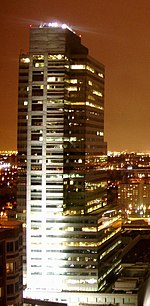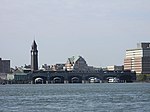PS Washington Irving

The PS Washington Irving was a 4,000-short-ton (3,600 t) sidewheel day boat and the flagship of the Hudson River Day Line that operated on the Hudson River from 1913 to 1926. The Washington Irving collided with an oil barge in the fog on 1 June 1926 on the North River. With the aid of tugboats, it reached shore at Pier 12, Jersey City, where it sank soon thereafter. Out of 200 passengers and 105 crew, three died as a result of the accident.Its removal was complicated due to its sinking upon the site of the Holland Tunnel, which was under construction. It remained submerged there until 13 February 1927, when it was raised and determined to be a total loss. A bond was issued for its replacement.
Excerpt from the Wikipedia article PS Washington Irving (License: CC BY-SA 3.0, Authors, Images).PS Washington Irving
Holland Tunnel, Jersey City Manhattan
Geographical coordinates (GPS) Address Nearby Places Show on map
Geographical coordinates (GPS)
| Latitude | Longitude |
|---|---|
| N 40.728778 ° | E -74.030882 ° |
Address
Holland Tunnel
Holland Tunnel
07310 Jersey City, Manhattan
New Jersey, United States
Open on Google Maps








